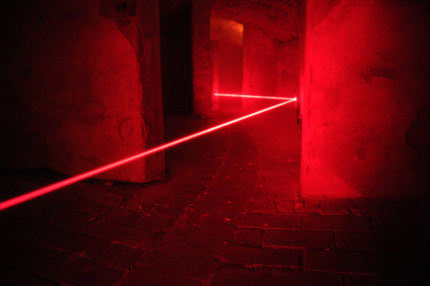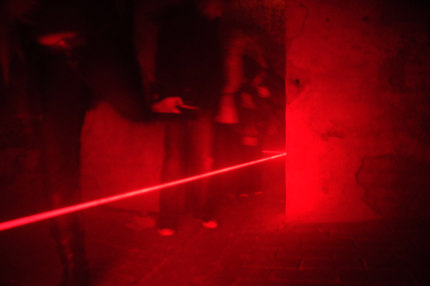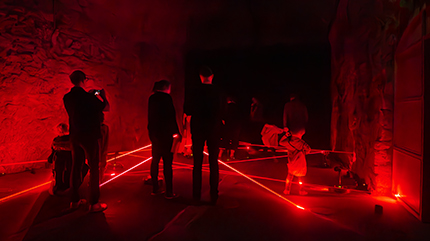
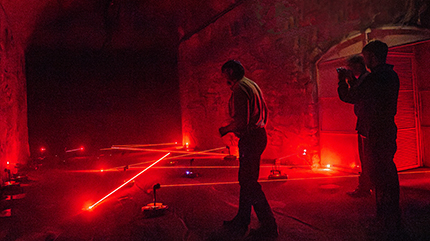
20 mobile lasers, programming © Margareta Hesse (both photos)
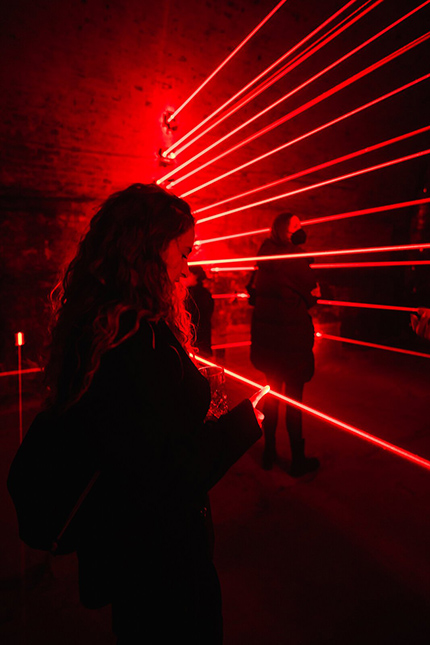
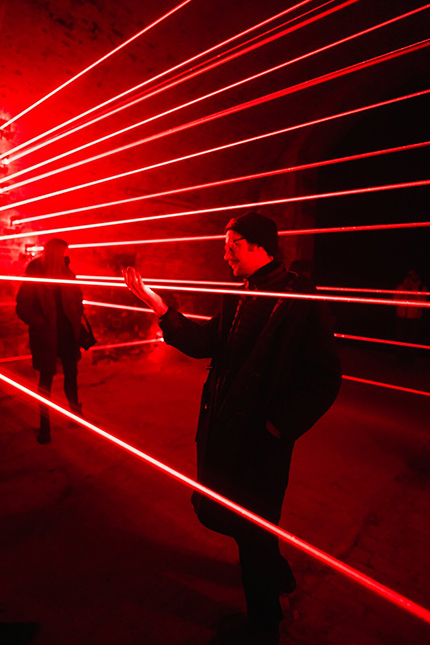
lasers, mirrors, sound © Carsten Beier (both photos)
´
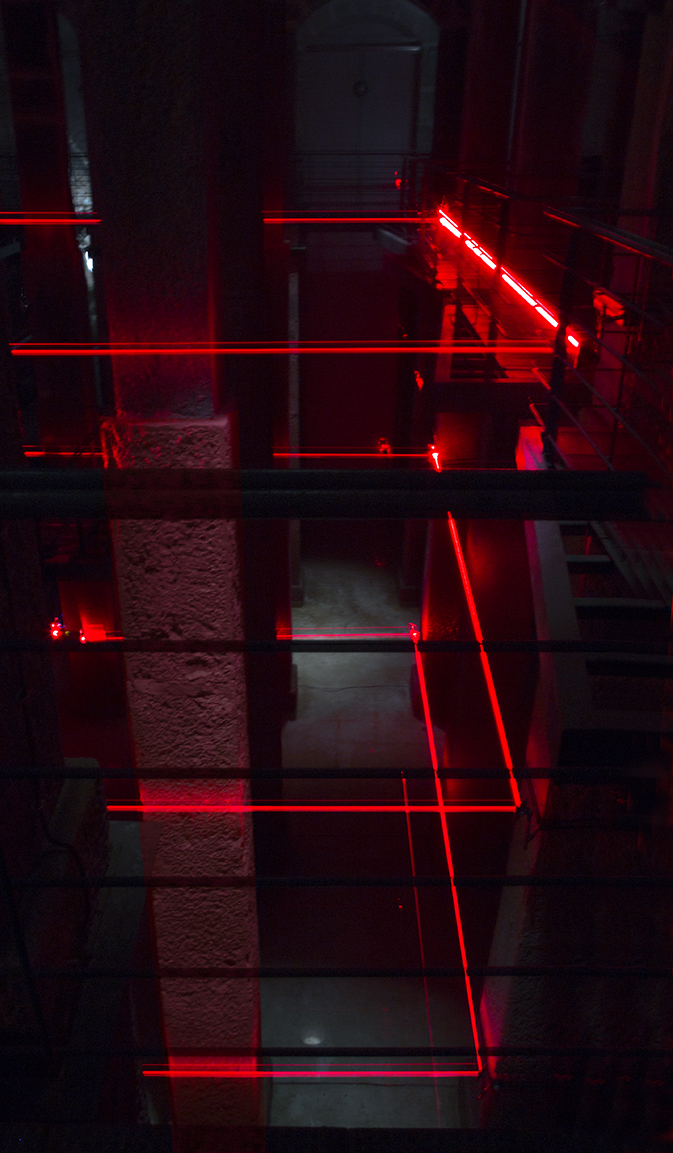
lasers, mirrors, sound © Margareta Hesse (photo) 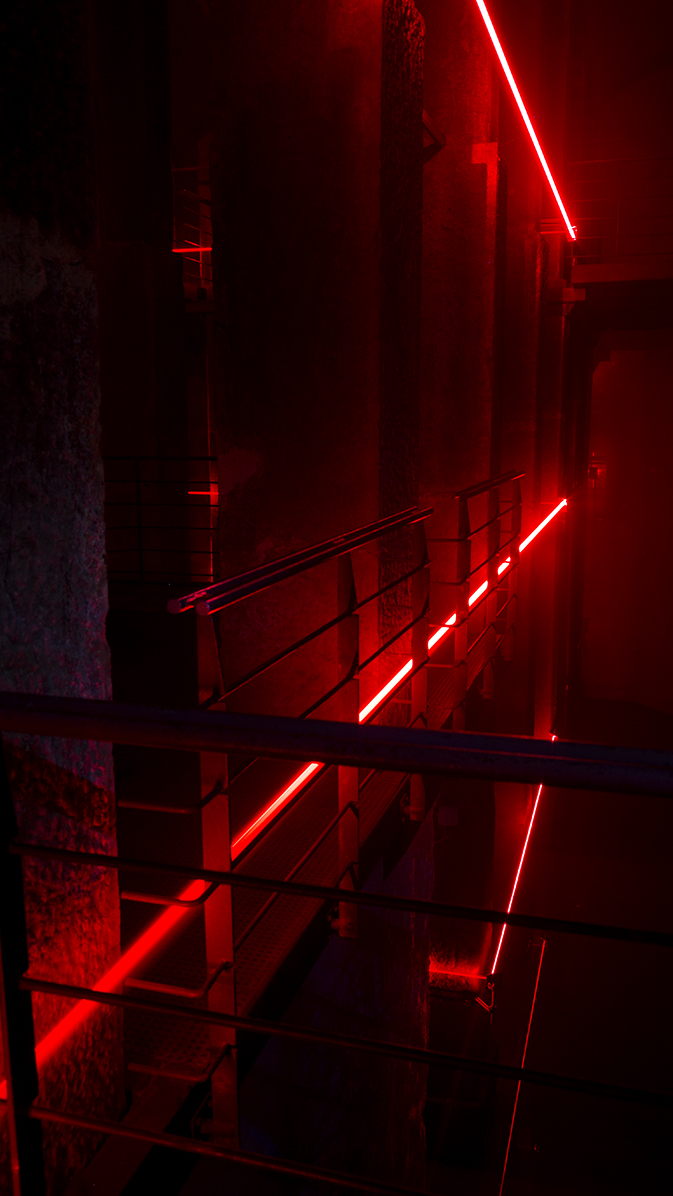
lasers, mirrors, sound © Margareta Hesse (photo)

lasers, mirrors, sound © Margareta Hesse (photo) 
lasers, mirrors, sound © Margareta Hesse (photo)
By Pamela C. Scorzin, Dortmund (Germany)/ Milan (Italy)
Colour and light are the creative media that exercise the greatest pull on Berlin artist Margareta Hesse as a creative medium for her work. In this voluntary reduction and in the constancy of subject, an enormous and fascinating variance simultaneously arises. It is expressed in the principle of the oeuvre cycle and in the modular arrange¬ments of her translucent pictures; but now also, and to a much greater extent, in a new series of light installations. Since autumn 2008, Hesse has included the modern technology of the laser as a creative medium in her site-specific installations. Thereby she has added significantly to what Peter Weibel has called contemporary Light Art from Artificial Light, with a non-artistic, industrial material which, compared to the light bulb, the fluorescent tube or LEDs, has only rarely found use by artists of the twentieth and so far, the twenty-first century. One might mention Robert Whitman's Solid Red Line of 1967 as an example, a laser beam rotating in a circle and drawing a red horizon on the walls of a darkened room; or Iannis Xenakis's Polytope II, a light and sound composition with electro-acoustic music on eight-channel tape and a laser instal¬lation, dating from 1972; or again, Adolf Luther's 1970 Laserraum, a variable indoor environment of ruby lasers, mirrors and an acrylic glass stele with a rotation motor. This and other examples of the experimental use of laser apparatus as part of an avant-garde Gesamtkunstwerk in the early 1970s will provide us below with art-historical points of reference and departure. At the same time, it is true that in the interim, laser technology has become an increasingly common feature in popular multimedia and other organised events, enactments, concerts and light shows. In this kind of summary contrasting and contextualising within more recent media history, Margareta Hesse's laser works soon stand out as highly original and singular. For her aim is neither to produce light effects for their own sake, nor to provide some popular laser entertainment of the kind to be observed in the dark season nowadays in many larger cities around the world, and in clubs. From a first passing glance one might excusably suppose a formal affinity with current interactive laser installations from the entertainment sector, such as rAys V2.0 by the Dutch group, Beyond Expression & IS (2008), where sixty-four ruby lasers form an intensely coloured grid field of light that interacts with discotheque audiences to generate and control further sounds and visuals. But Hesse's laser installations emerge as more austere in concept, more concentrated in their minimalism and more aware and thought-out in their meditative quality. In intention they owe allegiance wholly to the tradition of autonomous artistic making and so we may quite justifiably see in Hesse's current site-specific laser works, among other things, an express ion of the struggle for, and finding of, a well-wrought composition with a claim to ethical relevance and symbolic transcendence. 'None of that hectic conjuring with lines we are familiar with from laser shows. No gaudy helter-skelter of tricks for us to marvel at. (.) Beyond the generally familiar, entertaining motley of dancing laser installations, the point is to develop aesthetic, lean installations that provoke memorable encounters and a real interest in laser light on the part of the viewer. The effect of her laser installations thence lies in the generating of sensualist environments and atmospheric spaces for intense encounter in which perceptions, findings and experiences become amplified. Intervening in her found architectural spaces by means of artificial light, as does light artist Dan Flavin, for example, she transforms and atmospherically enhances them each into different spaces of compact sensory perception and experience. As an installation artist, Margareta Hesse is in the best sense of the term, a designer of experi¬ence. She shapes it. In doing so, the structural variability and visual diversity of her laser installations are determined causally by the specific architectural context: 'My laser installations arise out of the structure of the space / respond to the structure of the space,' the artist says. With a spot-on instinct, Hesse has the variable design of her light-space installations accord, too, to the technical definition of the formative material she has wittingly made her primary one - 'laser' being an acronym for 'Light Amplification by Stimulated Emission of Radiation', which involves a physical effect with which artificially directed, intense rays of light can be produced. The term 'laser' is applied not only to the effects of stimulation and amplification, but also to the source of the radiation itself. It was coined in the late 1950s by Gordon Gould. The Laser is a relatively recent technical invention, first realised in 1960 with a ruby crystal. The laser radiation effected has some very special properties that distinguish it from the artificial light from other electric light sources such as an incandescent light bulb or a fluorescent tube. According to the definition of Germany's Federal Office for Radiation Protection, these are: 1. Very high monochromaticity - it produces exactly one wavelength; 2. Coherency - the waves are 'in phase' both in time and in space, that is, in figurative terms, they vibrate exactly in parallel at the same speed. 3. Pronounced beam focussing, i.e. the diameter of the beam is very small even at a great distance from the source; 4. High density of beam - owing to the strong focus and great amplification of the radiation, rays will strike a small surface with great intensity. This can exceed the radiance of the sun many times over. Laser radiation can be produced in a relatively wide band of the optical spectrum. The range extends from the infra-red region through visible light to ultraviolet; the wave-lengths range from some 200 nm to about 10 000 nm. Lasers can also be classified according to whether they emit a continuous or a pulsed radiation. Pulsing lasers, for example, can emit many pulses at defined temporal rates, or they can emit single pulses. For special applications (such as nuclear fusion) extremely short individual pulses (with a duration of nanoseconds only) are produced, with peak performance at extraordi¬nary, megawatt or gigawatt levels (as at 17 June 2009). These properties have opened the way to numerous practical applications in medicine, technology, research and scientific theory as well as in our day-to-day lives. But only Margarete Hesse has now discovered the continuous-wave ruby laser for the visual arts. The thin laser beams become literally a thread (or in the German idiom, a red thread) that runs through a new sequence of works, as both a set of guidelines for them and an underlying motif. The bright red laser beams of this body of work draw glowing paths as it were, through its recurrent dark, hazy, unfamiliar spaces, and visitors to these regularly take up the guys of light as if the artist had handed them Ariadne's thread through labyrinths abounding in discoveries to be made and profound experiences to be had. But touching and taking hold of what appears to the eye as matter and as objective presences in all optical clarity and precision, instantly becomes an experience of evanescence into nothing at all, a shadow play - if not a dissolving into anxiety lest the laser light cutting through the darkness might not also physically injure one as onlooker. In our culture, glowing red symbolises the heart and love, eroticism and sensuality, or cosy warmth; but at the same time it portends destructive fire and red heat, blood and injury, danger and alarm. Between fascination and attrac¬tion on the one hand and danger and threat on the other, the respective manifestations of Margaret Hesse's ruby laser installations in her found interiors trigger emotions which, in their ambivalences, develop oscillation and violent undulating vibrations just as does the light as a physical phenomenon. The body of an interior thus articulated, enacted and choreographed by Margareta Hesse's light will permeate the space of the bodies of the viewers present. It is no longer possible to elude its emotional effect, since one has oneself become part of the installation at hand, with all one's senses. Just as industrial laser technology concentrates on a micro scale, so Hesse, on the macro scale of her interior environments, lucidly orders, directs, controls, stimulates and activates the sensory perceptions of her exhibition visitors. The process engages all the bodily senses to an equal extent. The visitors become immersed in dark and shadowy spaces to which light lends a new structure and a new rhythm. Now these interiors stir in the visitor a mobility, a finding of bearings and an exploring. Already in the art-historical precursors of contemporary installation art in the first half of the twentieth century, the artist's compositional intervention in the exhibition space, for example that of Marcel Duchamp in his proto-installation for the New York exhibition First Papers of Surrealism in 1942, Sixteen Miles of String, crucially determines the dramatic choreography of the visitors' subsequent behaviour and thus, too, how the work is experienced. Then, in this directed process of perception, further physical and sensory experiences are made possible, for example by olfactory, acoustic or tactile elements. Furthermore, the experience of warm and cold, of dust and stuffiness or of cool wet and mouldering damp that variously characterises the found spaces, sensitises the participating public to the illumi¬nating aesthetic of the beacons of this installation artist. Hesse's light installations also regularly incorporate essentially acoustic elements. Not least, the visitors' exploratory wanderings generate a natural acoustic back¬drop in the tenebrous, as if underworld, shadowy interiors. In them, the faculty of hearing seems more akin to that of vision. For each of her laser installations, the artist generates a specific, synthesised soundscape - a fictional, ominously disquieting hum and drone ostensibly from the laser beams in all their mesmerizing effect, whereas in reality they make no sound audible to the human ear at all, for all that George Lucas would have had us believe otherwise with his laser swords ('light sabers') in the hands of the Jedi and the Sith on the big Hollywood screen since generations of filmgoers past. The ambience of Hesse's installation spaces intensifies for all the senses into an overwhelming, all-encompassing work of art - but without slipping into superficial sensationalism or a mere 'event'. The contrary is true - the post-minimalist blueprint of her laser installations enables the artist to use the same technological apparatus - various laser instru¬ments, laser reflection mirrors, fastenings and optionally, hazers/ fog machines, to respond in a structurally variable way to the respective ambient circumstances as found and yet to create from this, experientially and perceptively, a cogent series of autonomous laser light spaces; or, as Margareta Hesse puts it, 'I draw glowing red lines of light, as it were, in space.' It is only consistent that she should have given these temporary space interventions with industrial laser light the generic, agenda title of lichtschneise - a path or cutting of light - also, in due course, numbering them, in straight series. In many respects her most elaborate and spec¬tacular laser installation to date was surely lichtschneise V (p. 46-56). In the spring of 2010, as part of the Luminale at the Mathildenhöhe in Darmstadt, Hesse installed her laser beams under the famed exhibition building by Joseph Maria Olbrich, in the blacked-out left-hand part of the historic reservoir. Pencils of light just one to two centimetres wide, nine glowing red beams in all, nigh-skimming the mirror of water in strict minimalist formation twenty centimetres over it, penetrated the dark recesses of the utility space that had been opened for the duration of the exhibition for the public to walk through. A purely rational angle might have suggested that the laser beams were fathoming and exploring the width of the succession of chambers between the mighty piers supporting the vaults of the old functional building, down to the depths of its back wall. In combination with the misty-dank ambient atmosphere and the specific acoustics of the wave motions caused by the visitors in the clear water, along with its wavering reflections, however, the rigorously arranged and geometrically subdivided picture of the space became a more faceted thing, the outcome a quite extraordinary experiential space and a unique site of and witness to 'reflections'. So Hesse's interventions with the laser beam are always of an ephemeral kind. They transform the ambient space of their host interiors and architectural structures for the duration of the installation only, without lastingly changing those sites themselves in their material state and sub-stance. Only for a certain time is a physically present public presented there with something new, fascinating and astonishing to discover and experience. The artist's temporary laser installations endure as art works only in the memory of the visitors and in the written and pictorial records; and these records possess a reality of their own, secondary and never quite adequate in relation to the direct, physical and cognitive experience. Spatial-temporal perceptions and emotional experiences on the part of the public that is immersed with all the senses in three-dimensional installation environments, are flattened into two-dimensional images, called 'installation view'. Nonetheless, photographic installation views as well as videos such as the artist produces for her series of licht¬schneisen and reproduces in catalogues, do illustrate vividly, as in the present volume, how ideally the visual and the performing arts converge. The exhibition visitors themselves become in Margareta Hesse's laser light spaces, not only participants but also active protagonists and performers. 'The viewers who cross the space see themselves directly confronted with the glowing, red laser beams and must decide whether they will move around only on the path between the laser beams, step over them or cross the beam - in which process they would, for an instant, interrupt the rest of the progress of the beam, and thereby themselves alter the light tracks play-fully in stages, and create zones of bright light. Hesse's very first laser installation was shown on the occasion of her one-woman show, lichtspuren, etappen¬weise at the ,Unser Fritz' Künstlerzeche, a pithead monument artists centre at Herne in the Ruhr area in the autumn of 2008. The hands-on artistic engagement with a relatively low, barrel-vaulted former adit penetrating some fifty metres into a disused mine in the Ruhr area, deep under the galleries in the Herne pithead art space, a subterranean work as the Darmstadt installation was to be later, took Hesse for the first time to the use - the featured use - of industrial laser light. Here the laser light installation lichtschneise I came about with its post-minimal aura as a concentrated, glowing-red ray of laser light pencilling at calf-height through the centre of the pitch-dark labyrinthine adit vaulting (p. 4-10). A further environment of glowing red laser beams with the appearance of physical objects was installed in the dank mustiness of the bunker of the Design Department of Dortmund's Fachhochschule (University of Applied Sciences and Arts), where Margareta Hesse has been holding a chair for Foundations of Design and Illustration since 1995. In 2009, lichtschneise III (p. 18-20) was shown as a contribution to the group exhibition, 1 : 11 Heimvorteil in a 'white cube' space darkened for the purpose, an almost square passageway in the renowned Museum am Ost¬wall in Dortmund. There, the viewer had to traverse a medium of artificial fog and embedded in this, a knee-high grid of precisely parallel lines of light produced by a laser beam meandering by dint of deflector mirrors mounted on the walls - thus to arrive in the next gallery of the exhibition. As soon as the viewer physically crossed this object-like, one to two-centimetre-thick laser beam, however, the linear light path was interrupted instantly up to the end of its erstwhile course, whilst the laser beam now 'landed' at the point of the physical interaction and contact, with an intense, even perilous-seeming, incandescent trace. No sooner did the perceiver step out of the beam's path, however, but the light installation became visible again in its comprehensive illuminating totality. In the variant entitled lichtschneise IV (p. 22-28), which featured in the same year in the solo exhibition, Lichtzone, in the casemates of the Königin bastion of Berlin's citadel, the laser is used for a different effect, two beams cutting through a very long path, ultimately to end in a small antechamber where, again at calf height only, they form a floating, but material-seeming, intensely luminous spatial grid. Following lichtschneise VI (p. 30-36), which Hesse installed in the Kunstverein Linz a. Rh., she has completed what is for the time being her last realisation of the installation sequence, with lichtschneise VII. In this new variation on her light installation, in the warehouse of the Elbeforum in Brunsbüttel, Hesse has sought to work for the first time with a series of lasers that, animated and under random control, move through the stage-set of the darkened warehouse autonomously. Equipped with finely-tuned sensors, these five mobile lasers come to a halt before any obstacle they might meet, be it a wall, an object or a human being, only to set off without delay in an abrupt change of direction, continuing their progress with their rays of light fathoming and scanning the am¬bient space. Meanwhile the visitors to the exhibition can pace the spatial arena of the mobile laser installation while the red laser beams emitted by the teeming pieces of apparatus slowly glide about the space at knee height and a fascinating ballet of light between humans and technology unfolds, releasing a tumult of emotions between beauty, fascination and alarm.
" To send light into the profundities of the human heart, such is the artist's vocation."
Robert Schumann
footnotes
i Peter Weibel/ Gregor Jansen (eds), Light Art from
Artificial Light. Light as a Medium in 20th and 21st
Century Art (Ostfildern: Hatje Cantz 2006)
ii Cf. www.beyondexpression.nl/rays, and a video record of this laser project on the Internet, at http://vimeo.com/1181601 iii Statement by Margareta Hesse in an exposé for the laser installations, unpublished iv Margareta Hesse in an interview with the author at Darmstadt, April, 2010 v See http://en.wikipedia.org/wiki/Laser and e.g., the Health Protection Agency's website at http://www.hpa. org.uk/Topics/Radiation/UnderstandingRadiation/Under-standingRadiationTopics/Lasers/ A German equivalent (with English lang. option) on the Internet is provided by the Federal Office for Radiation Protection at http://www.bfs.de/en/uv/laser vi See http://www.bfs.de/en/uv/laser vii On the health hazards of the laser, the Fed. Off. for Radiation Protection in Germany states on its Internet website, 'Biological and health effects of laser radiation are similar to those of normal optical radiation. They depend strongly on wavelength. The range of wave¬length of laser radiation extends from approx. 10 000 nm to approx. 200 nm, i.e. from infrared via visible light to UV radiation. Since penetration depth into biological tissue is relatively low mainly skin and eyes are affected if laser radiation impacts accidentally on humans. Particular danger exists for the eyes due to their optical properties. The very high power density and the strong focussing of laser beams can result in special health risks.' viii Margareta Hesse in conversation with the author, Dortmund, December, 2010 ix See the video record of the temporary laser installation, lichtschneise V at the historical water reservoir at Mathildenhöhe, Darmstadt, on the Internet - at http://vimeo.com/17213055 (produced by Margareta Hesse and Oliver Lechner, 2010) x From the press release by the Institut Mathildenhöhe for the exhibition, lichtschneise V (2010) |
||||
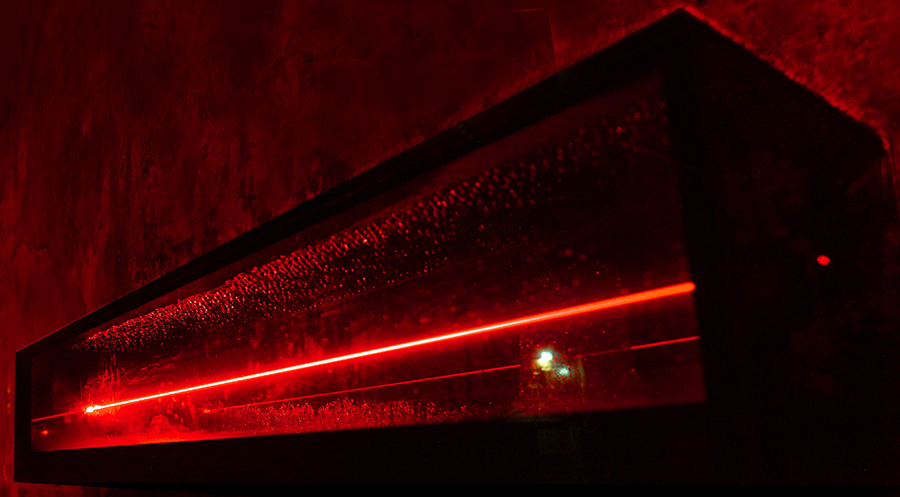 "Caged Light", 2022, laser object, exhibition Centre for International Light Art, Unna (Germany)
"Caged Light", 2022, laser object, exhibition Centre for International Light Art, Unna (Germany) 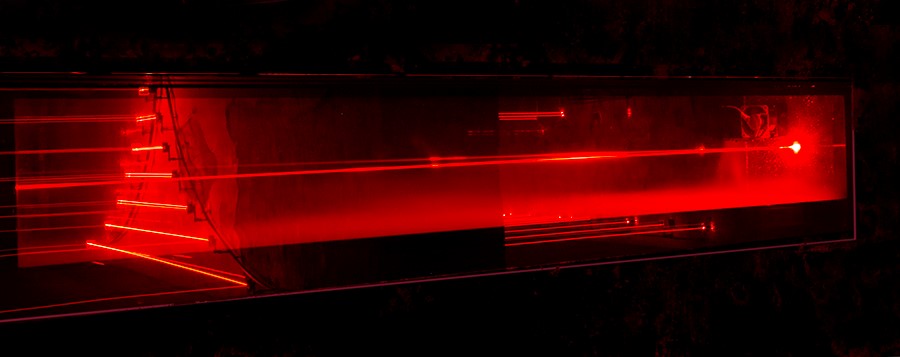 "Caged Light", 2022, laser object (with reflections of the opposite installations), exhibition Centre for International Light Art, Unna (Germany)
"Caged Light", 2022, laser object (with reflections of the opposite installations), exhibition Centre for International Light Art, Unna (Germany)  "Caged Light", 2022, laser object, exhibition Centre for International Light Art, Unna (Germany)
"Caged Light", 2022, laser object, exhibition Centre for International Light Art, Unna (Germany) 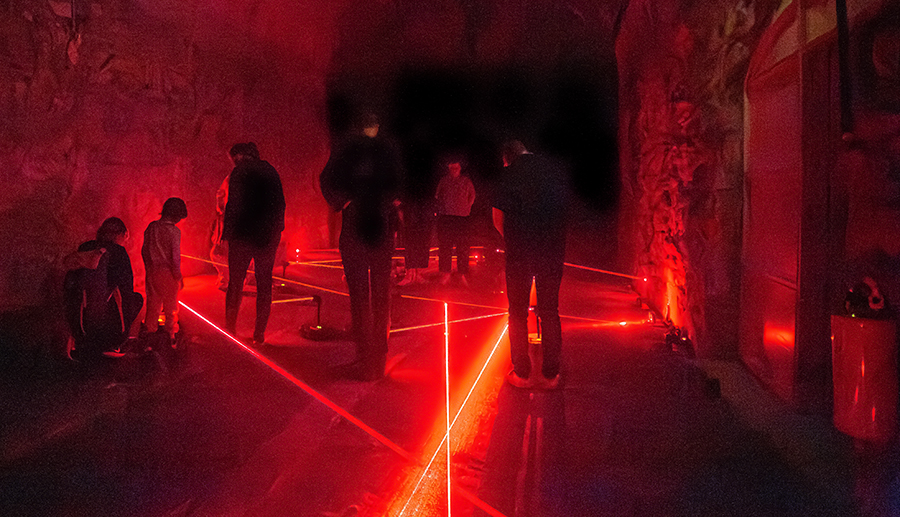 "Irrlichter (Ghost Lights)", 2023, laser installation, exhibition Centre for International Light Art, Unna (Germany)
"Irrlichter (Ghost Lights)", 2023, laser installation, exhibition Centre for International Light Art, Unna (Germany) 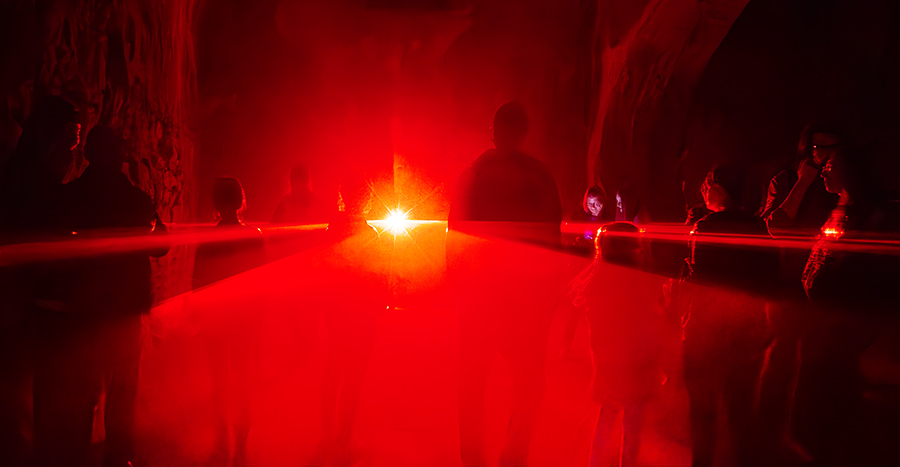 "Lichtebene (Light Plane)" 2023, laser installation, exhibition Centre for International Light Art, Unna (Germany)
"Lichtebene (Light Plane)" 2023, laser installation, exhibition Centre for International Light Art, Unna (Germany) 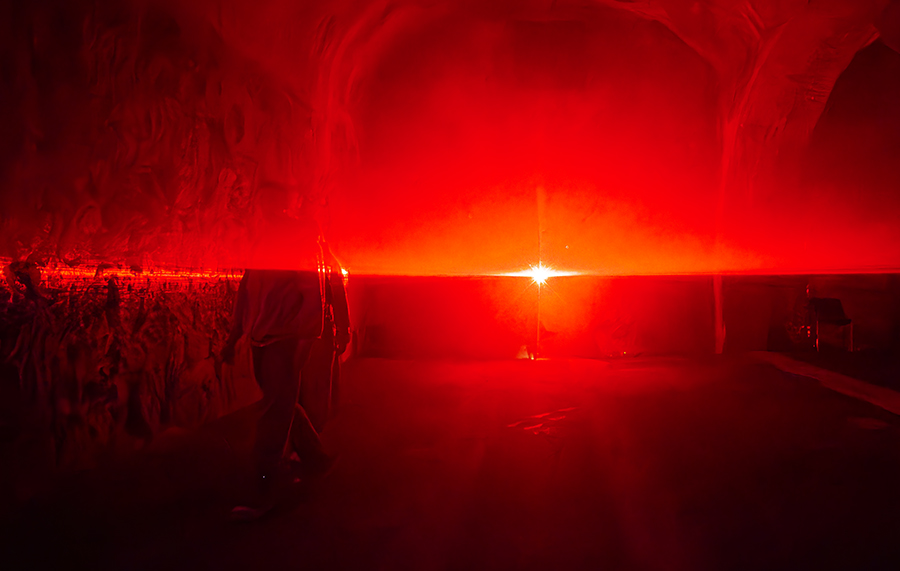 "Lichtebene (Light Plane)" 2023, laser installation, exhibition Centre for International Light Art, Unna (Germany)
"Lichtebene (Light Plane)" 2023, laser installation, exhibition Centre for International Light Art, Unna (Germany) 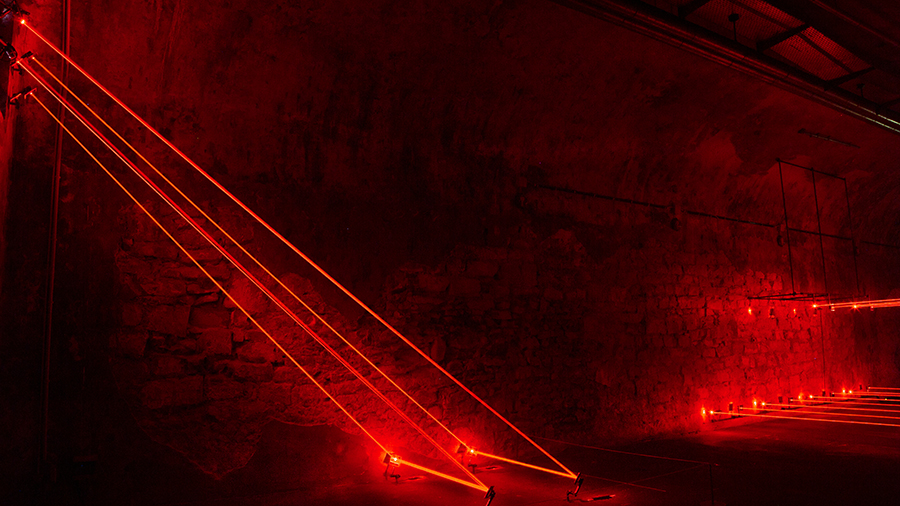 "Lüftungsstrahlung" 2023 and "Light Trap III" 2023, laser installation, exhibition Centre for International Light Art, Unna (Germany)
"Lüftungsstrahlung" 2023 and "Light Trap III" 2023, laser installation, exhibition Centre for International Light Art, Unna (Germany)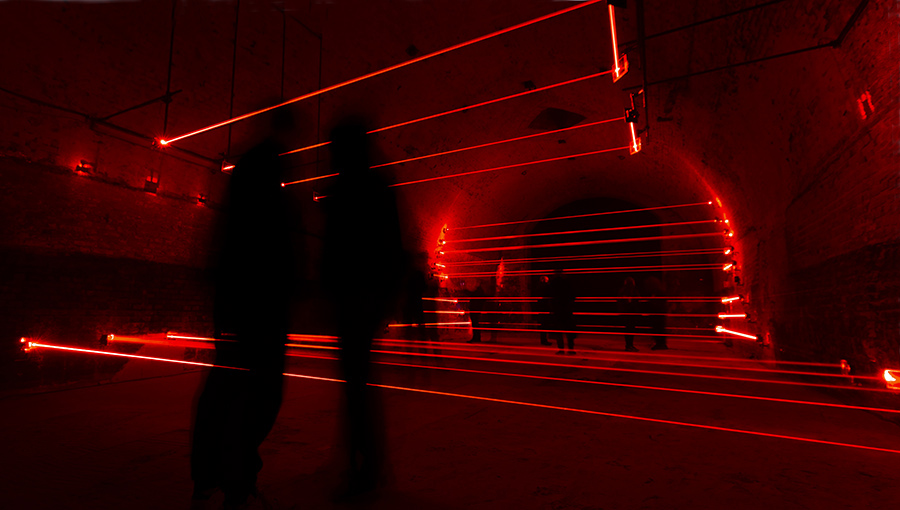 "Lightwave" 2022, laser installation, exhibition "Himmel unter Berlin", previous Bohemian brewery, Berlin-Friedrichshain (Germany)
"Lightwave" 2022, laser installation, exhibition "Himmel unter Berlin", previous Bohemian brewery, Berlin-Friedrichshain (Germany)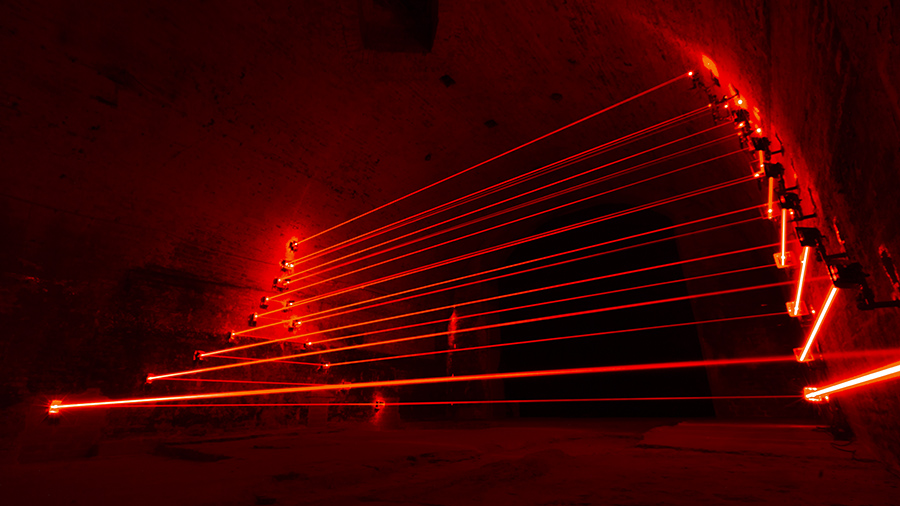 "Lightwave" 2022, laser installation, exhibition "Himmel unter Berlin", previous Bohemian brewery, Berlin-Friedrichshain (Germany)
"Lightwave" 2022, laser installation, exhibition "Himmel unter Berlin", previous Bohemian brewery, Berlin-Friedrichshain (Germany)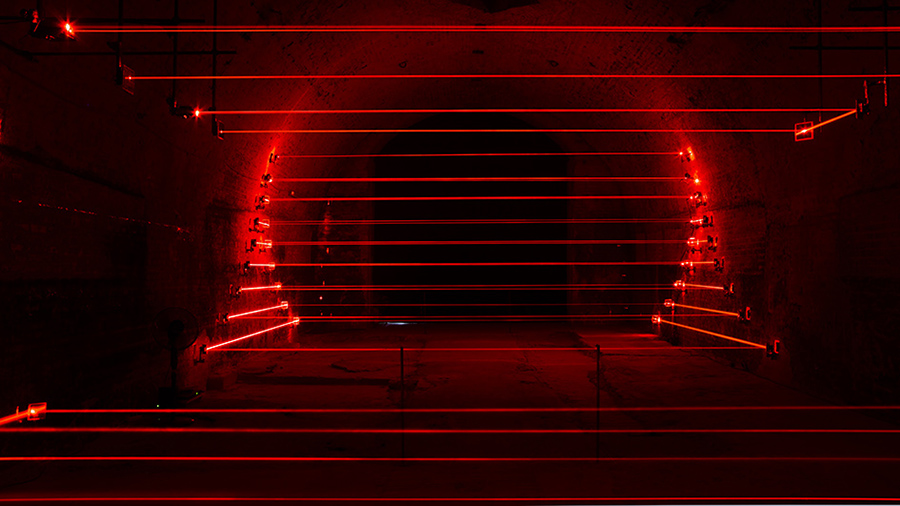 "Lightwave" 2022, laser installation, exhibition "Himmel unter Berlin", previous Bohemian brewery, Berlin-Friedrichshain (Germany)
"Lightwave" 2022, laser installation, exhibition "Himmel unter Berlin", previous Bohemian brewery, Berlin-Friedrichshain (Germany)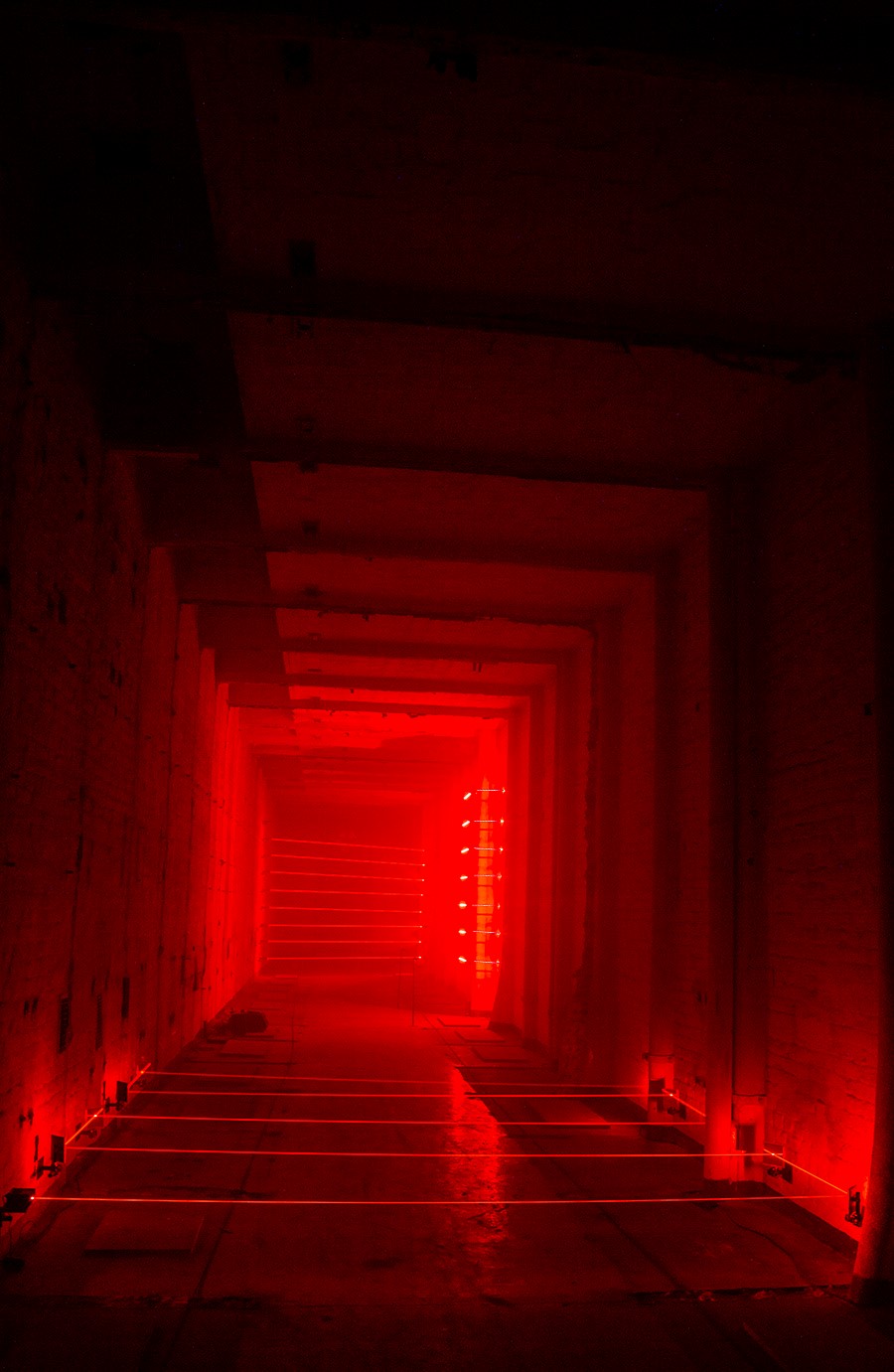 "sculptured light I, IV, V" 2021, laser installation, LOST Art Festival,previous transformer station, Berlin (Germany)
"sculptured light I, IV, V" 2021, laser installation, LOST Art Festival,previous transformer station, Berlin (Germany)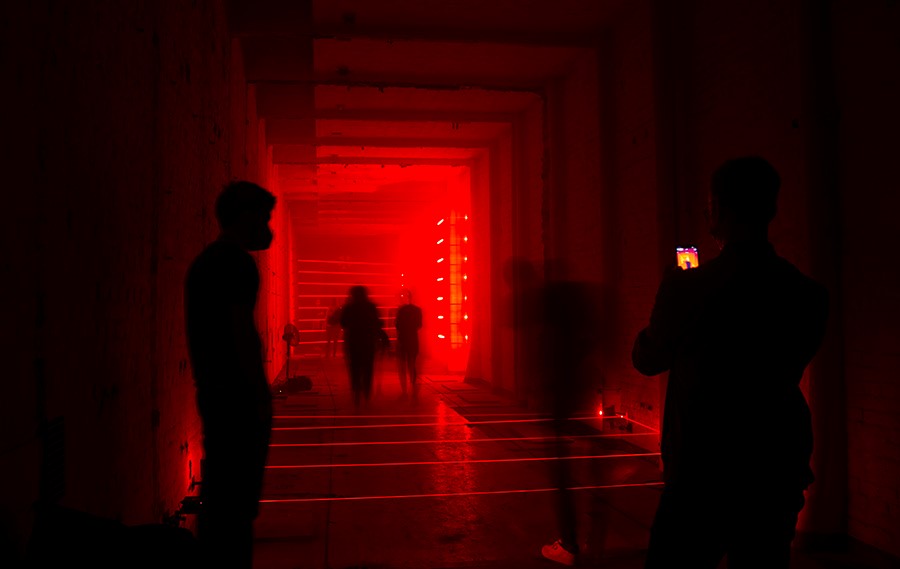 "sculptured light I, IV, V" 2021, laser installation, LOST Art Festival,previous transformer station, Berlin (Germany)
"sculptured light I, IV, V" 2021, laser installation, LOST Art Festival,previous transformer station, Berlin (Germany)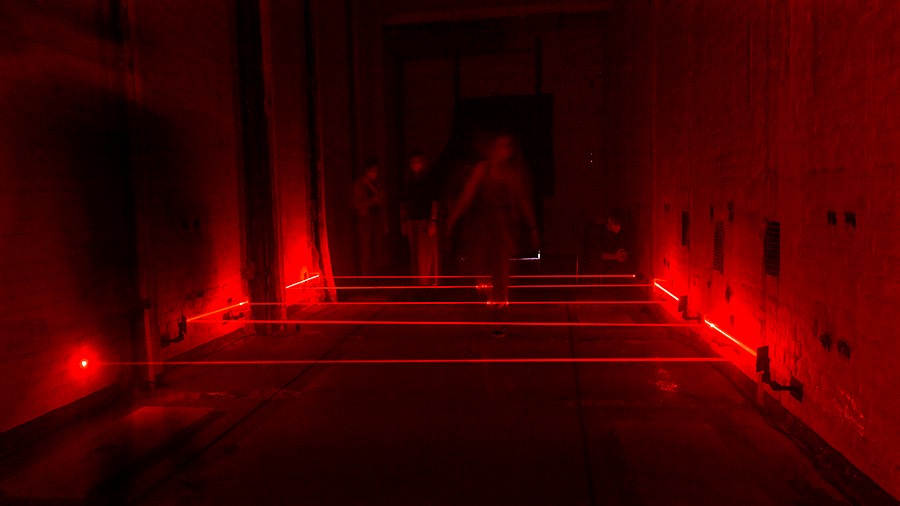 "sculptured light I, IV, V" 2021, laser installation, LOST Art Festival,previous transformer station, Berlin (Germany)
"sculptured light I, IV, V" 2021, laser installation, LOST Art Festival,previous transformer station, Berlin (Germany)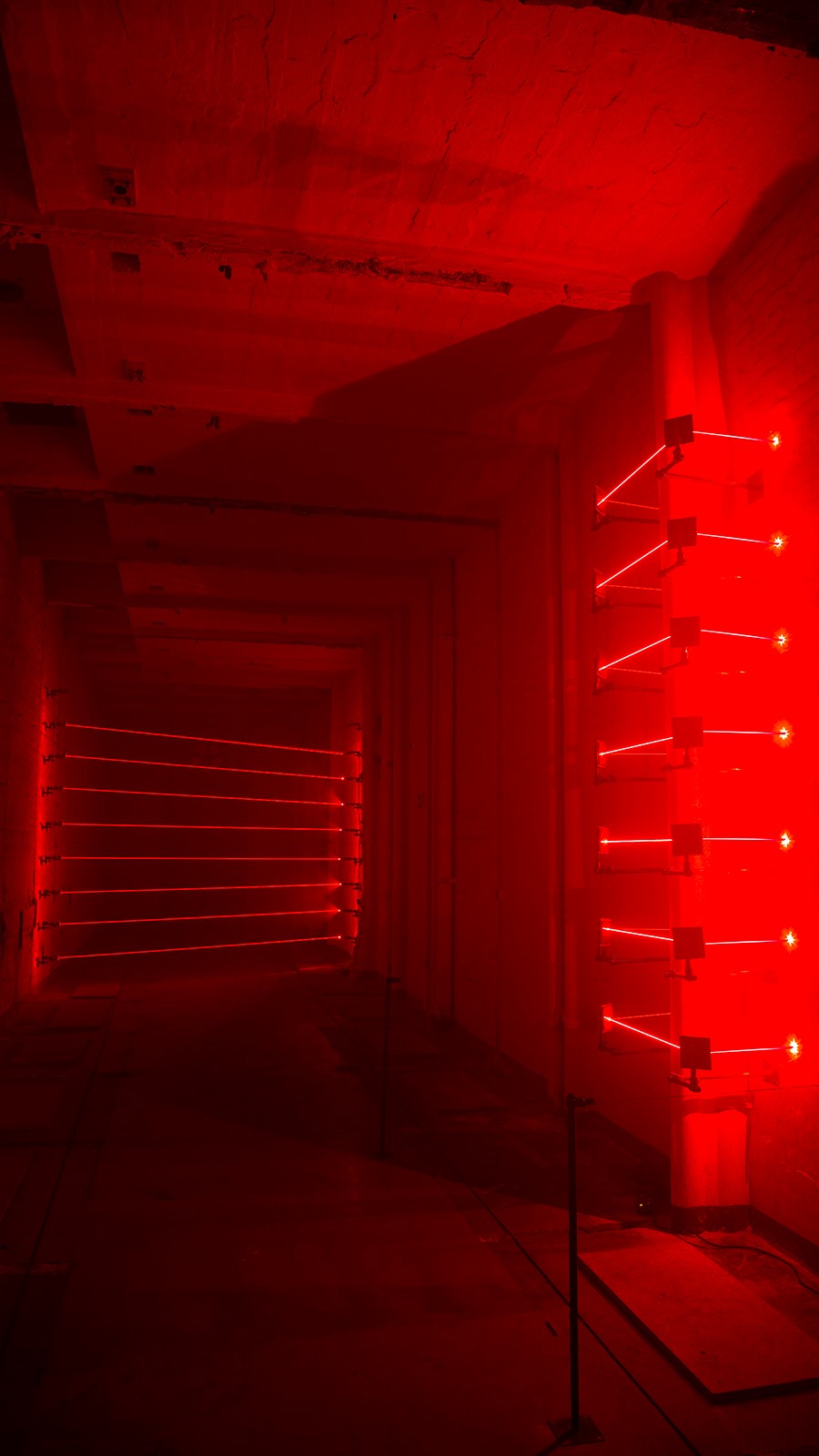 "sculptured light I, IV, V" 2021, laser installation, LOST Art Festival,previous transformer station, Berlin (Germany)
"sculptured light I, IV, V" 2021, laser installation, LOST Art Festival,previous transformer station, Berlin (Germany)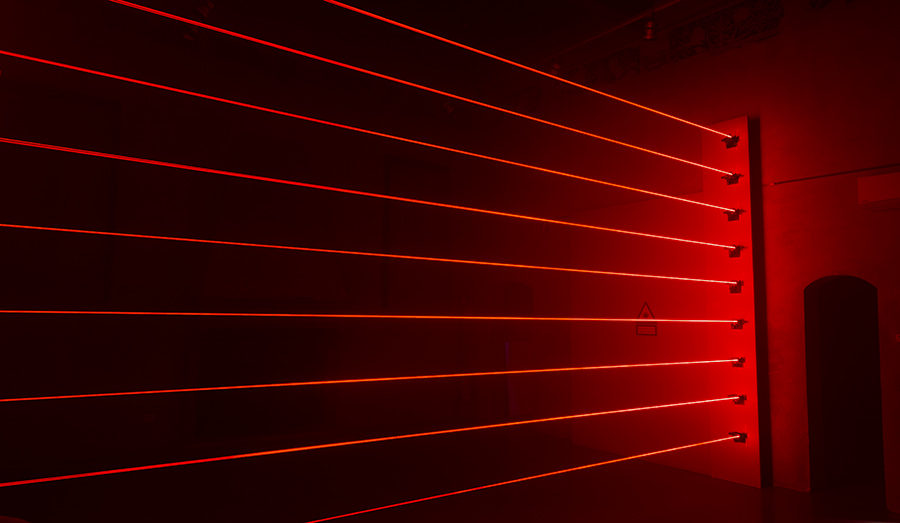 "Sculptured light I" 2020, laser installation, Biennale Light Art, Mantova (Italy)
"Sculptured light I" 2020, laser installation, Biennale Light Art, Mantova (Italy)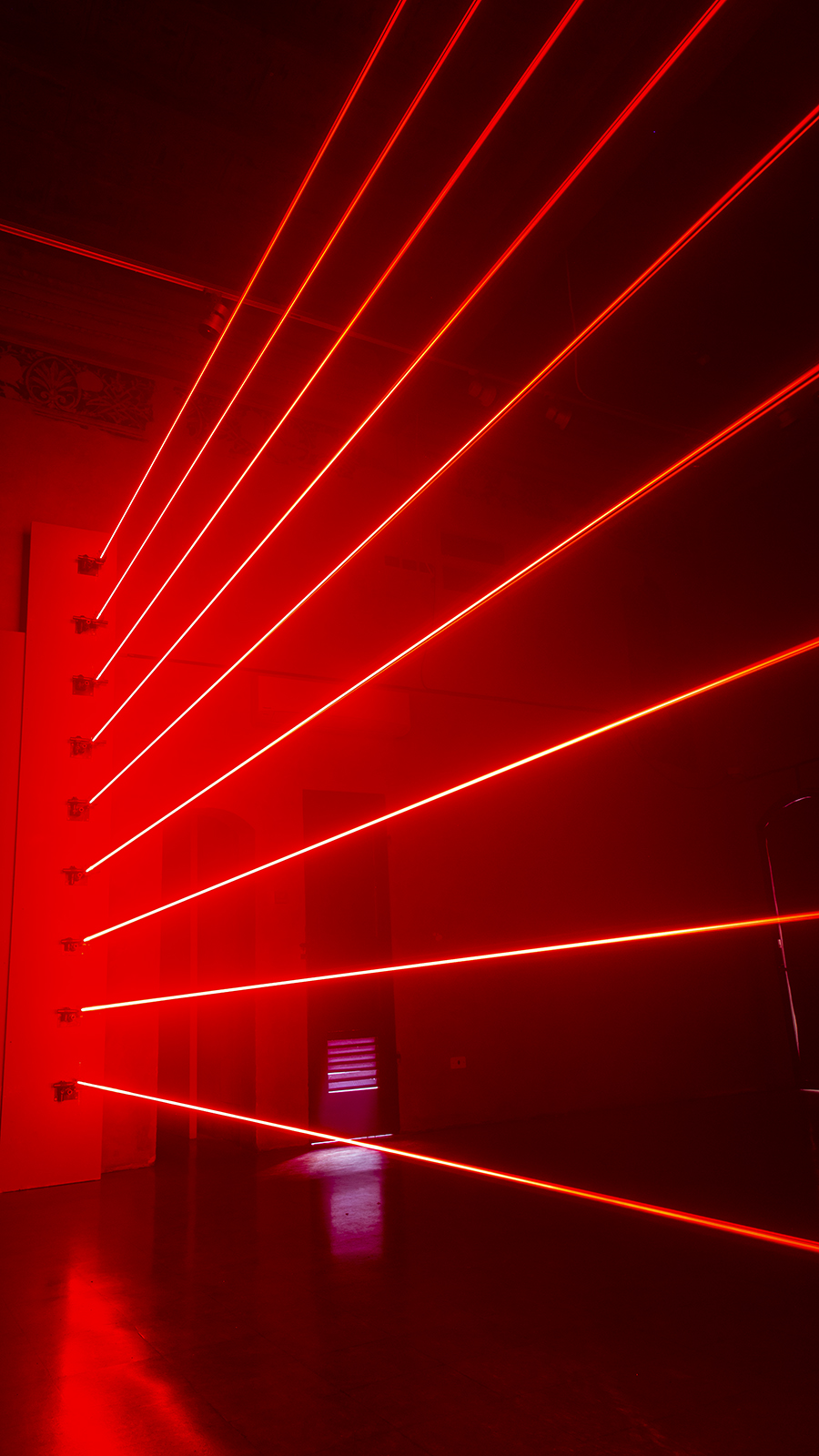 "Sculptured light I" 2020, laser installation, Biennale Light Art, Mantova (Italy)
"Sculptured light I" 2020, laser installation, Biennale Light Art, Mantova (Italy)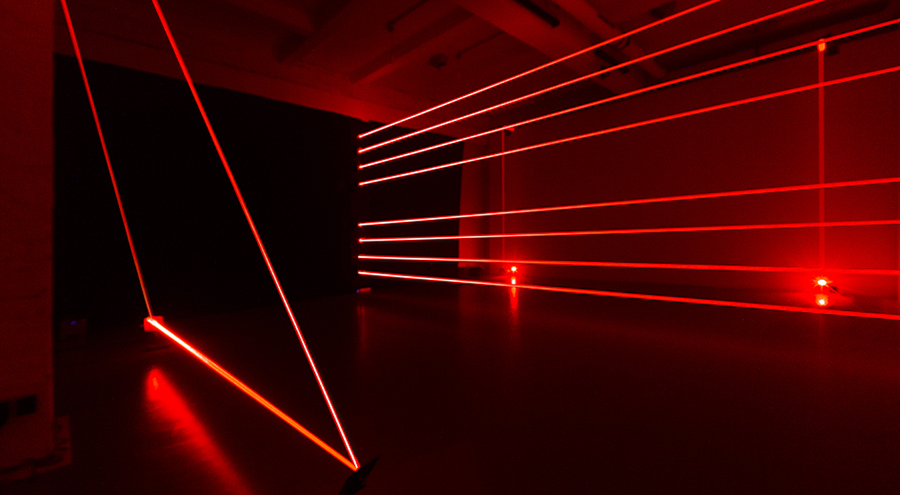 "Sculptured light I-III" 2020, laser installation in the Gallery Floss & Schultz, Cologne (Germany)
"Sculptured light I-III" 2020, laser installation in the Gallery Floss & Schultz, Cologne (Germany)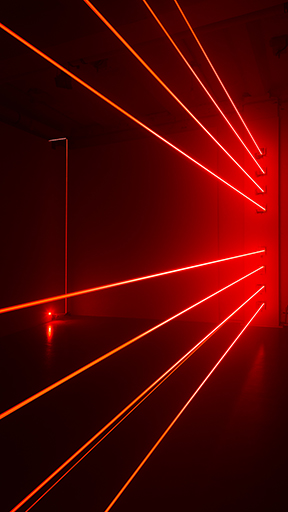 "Sculptured lightI-II" 2020, laser installation in the Gallery Floss & Schultz, Cologne (Germany)
"Sculptured lightI-II" 2020, laser installation in the Gallery Floss & Schultz, Cologne (Germany)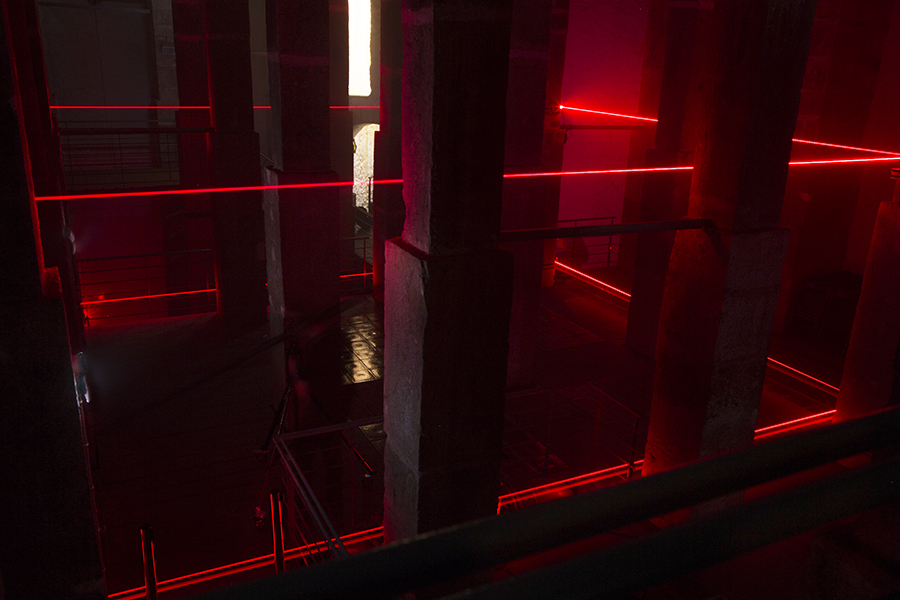 „ILHAS LUZ“ 2018, Lisbon (Portugal), laser installation
in the Reservatório da Patriarcal, Lisbon (Portugal)
„ILHAS LUZ“ 2018, Lisbon (Portugal), laser installation
in the Reservatório da Patriarcal, Lisbon (Portugal)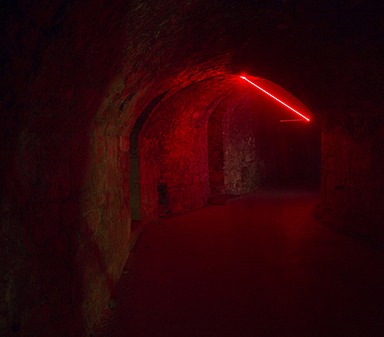
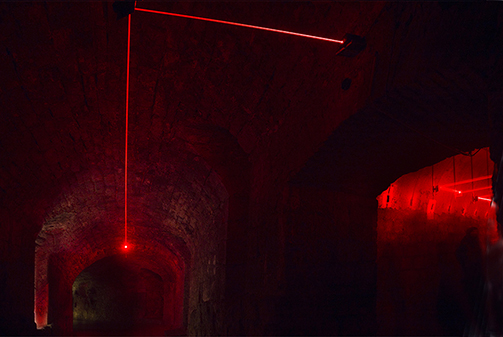 „Lichtfalle“ 2018 in the context
of the International Light Biennal „Lichtungen“
„Lichtfalle“ 2018 in the context
of the International Light Biennal „Lichtungen“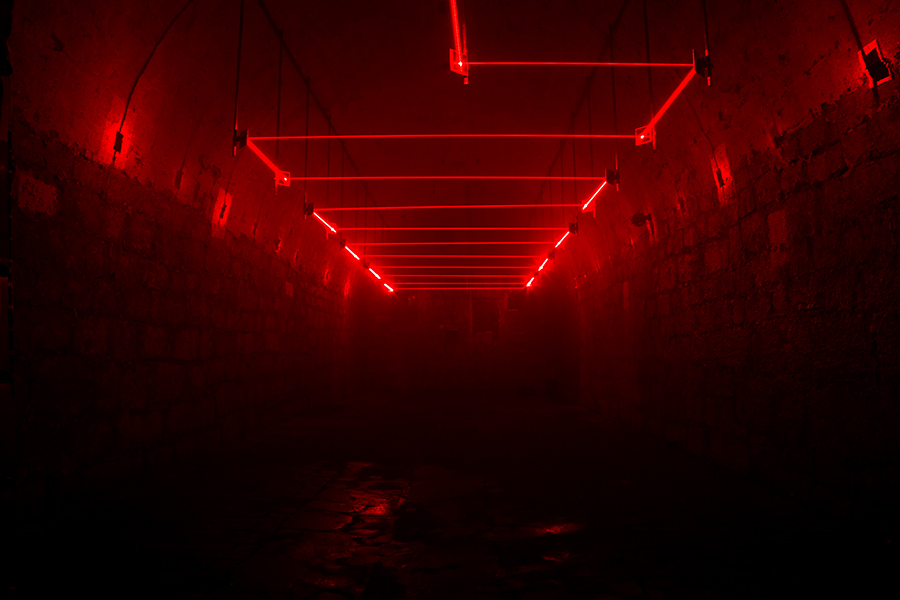 „Lichtfalle“ 2018 in the context
of the International Light Biennal „Lichtungen“
„Lichtfalle“ 2018 in the context
of the International Light Biennal „Lichtungen“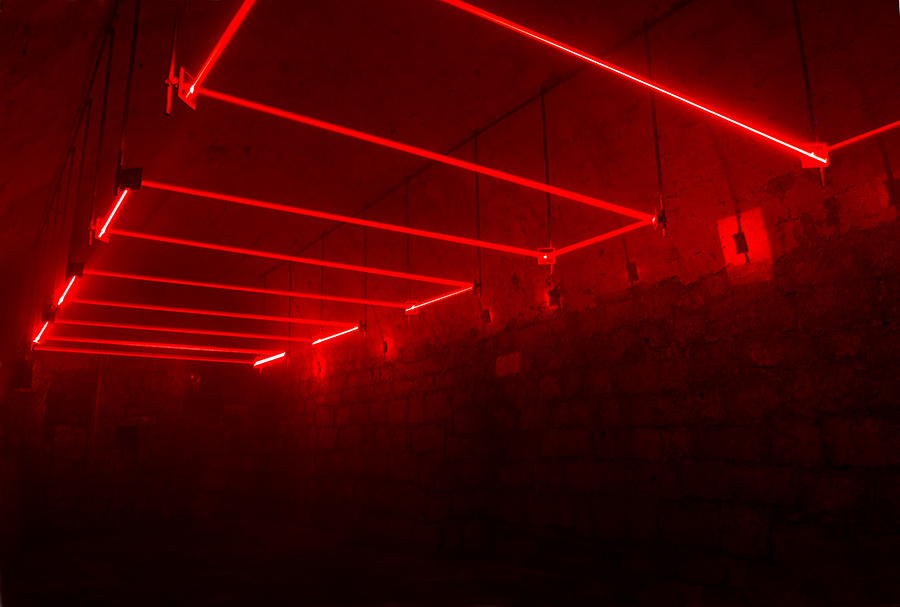 „Lichtfalle“ 2018 in the context
of the International Light Biennal „Lichtungen“
„Lichtfalle“ 2018 in the context
of the International Light Biennal „Lichtungen“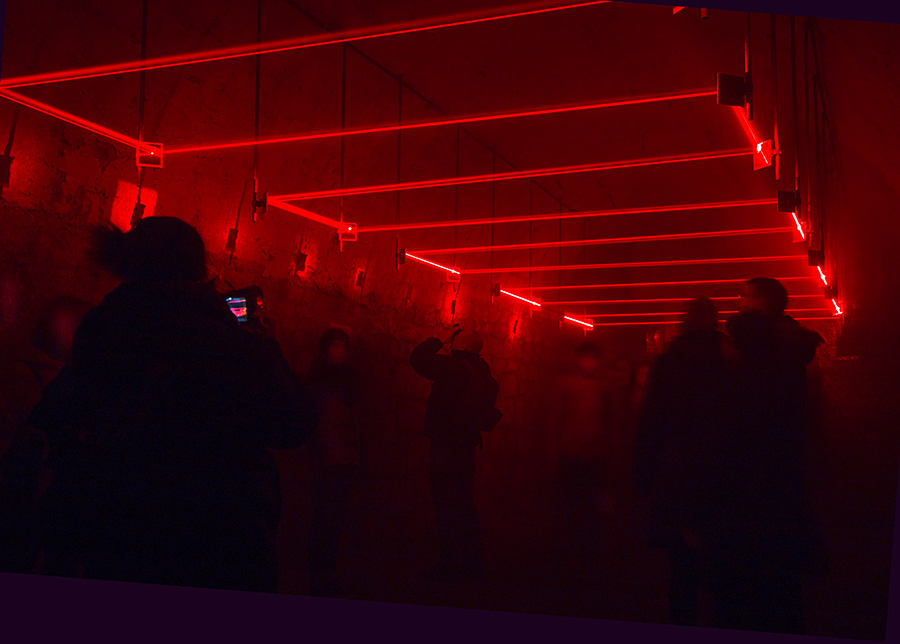 „Lichtfalle“ 2018 in the context
of the International Light Biennal „Lichtungen“
„Lichtfalle“ 2018 in the context
of the International Light Biennal „Lichtungen“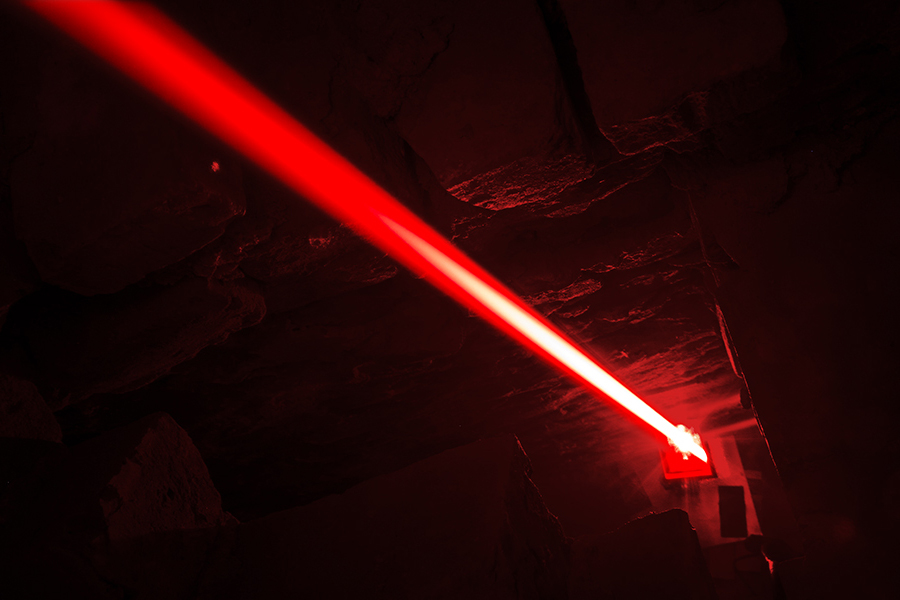 „Licht - Raum - Erkundungen“ 2017, Kommunale Galerie Historischer Keller,
„Licht - Raum - Erkundungen“ 2017, Kommunale Galerie Historischer Keller,
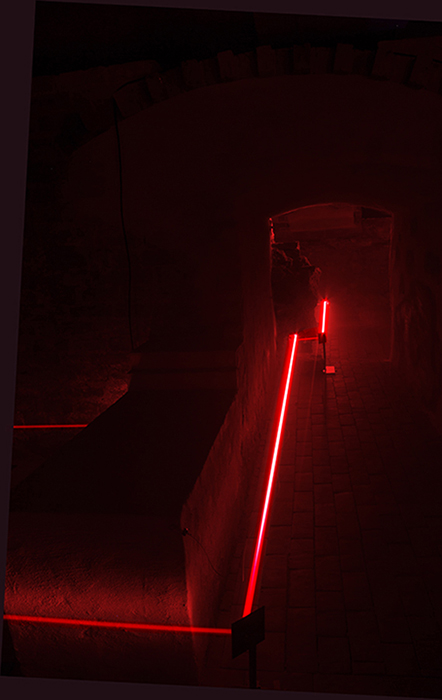
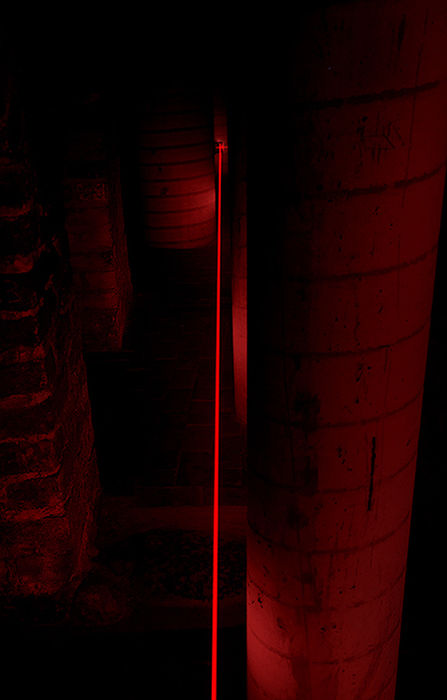 „Licht - Raum - Erkundungen“ 2017, Kommunale Galerie Historischer Keller,
„Licht - Raum - Erkundungen“ 2017, Kommunale Galerie Historischer Keller,
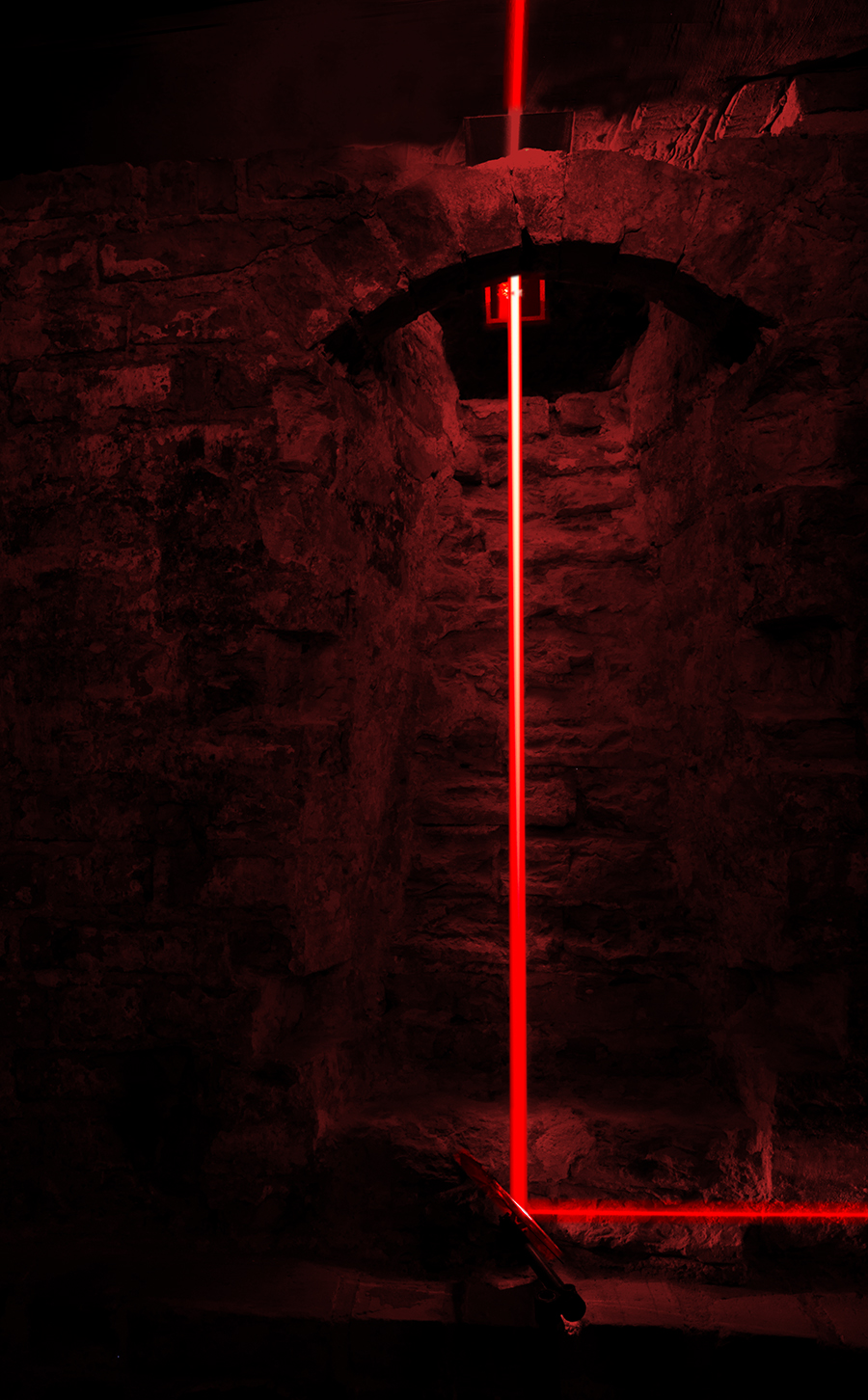 „Licht - Raum - Erkundungen“ 2017, Kommunale Galerie Historischer Keller,
„Licht - Raum - Erkundungen“ 2017, Kommunale Galerie Historischer Keller,
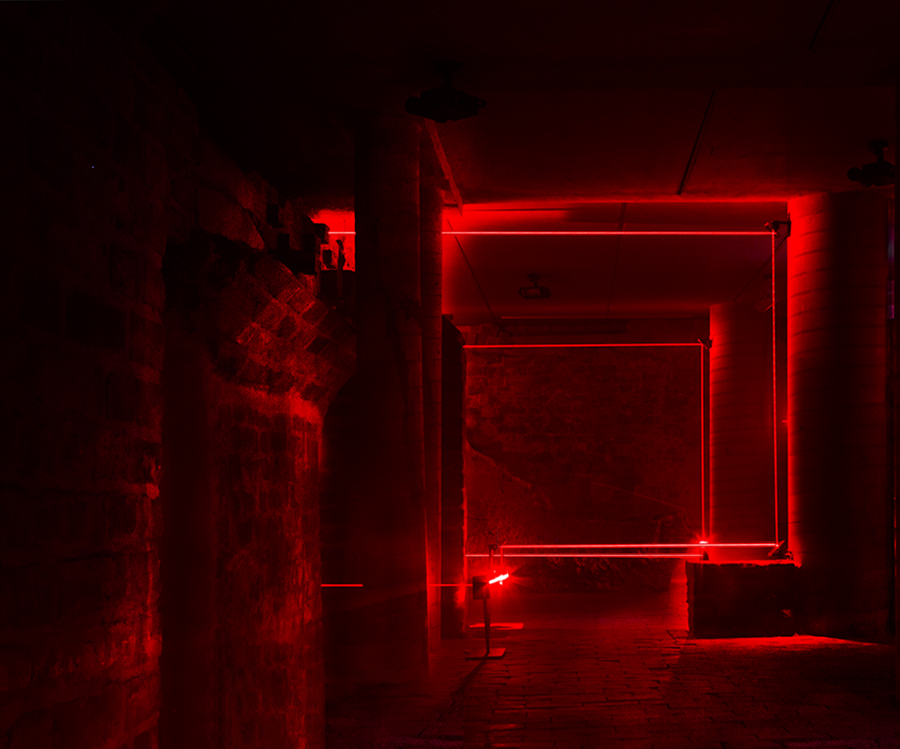 „Licht - Raum - Erkundungen“ 2017, Kommunale Galerie Historischer Keller,
Berlin (Germany)
„Licht - Raum - Erkundungen“ 2017, Kommunale Galerie Historischer Keller,
Berlin (Germany)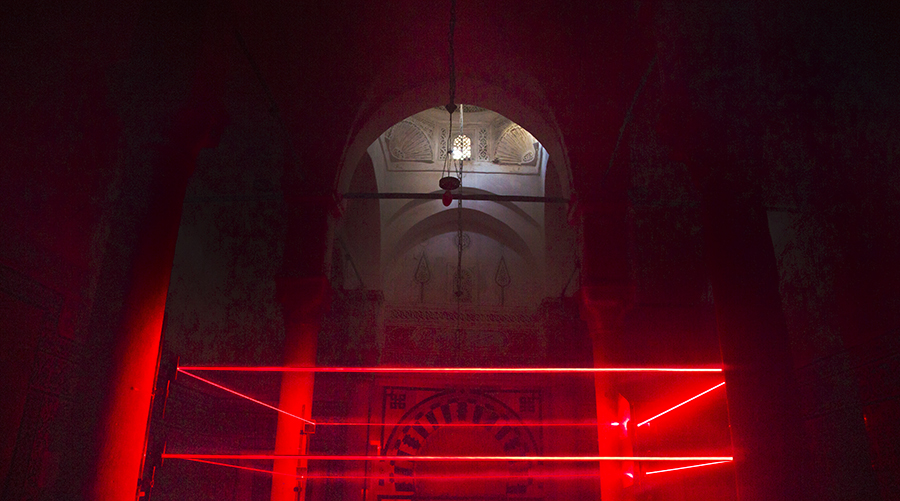 "Bordering Light" 2016, laser installation in the Madrasa Bir Lahjar, Tunis (Tunesia)
"Bordering Light" 2016, laser installation in the Madrasa Bir Lahjar, Tunis (Tunesia)
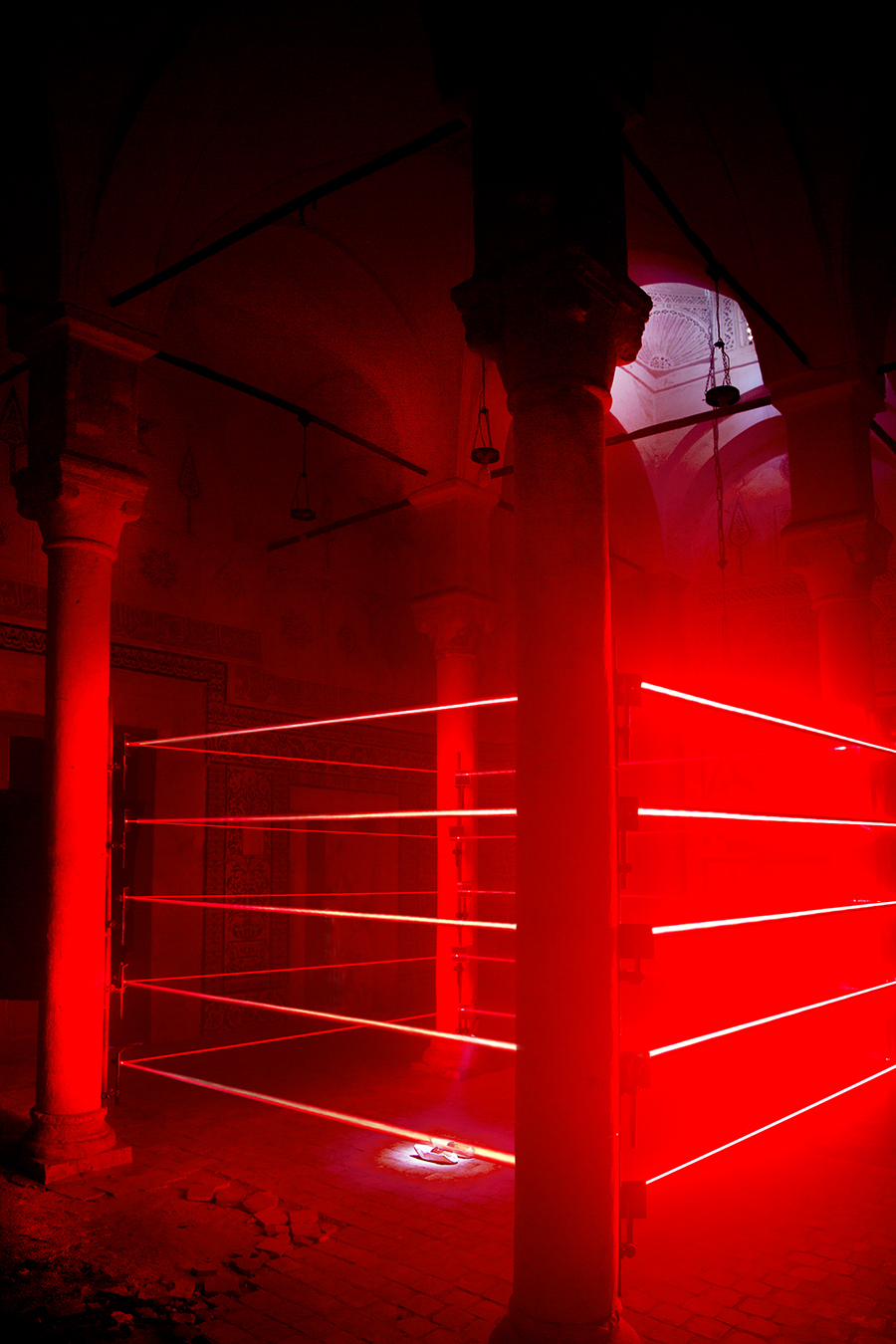 "Bordering Light" 2016, laser installation in the Madrasa Bir Lahjar, Tunis (Tunesia)
"Bordering Light" 2016, laser installation in the Madrasa Bir Lahjar, Tunis (Tunesia)
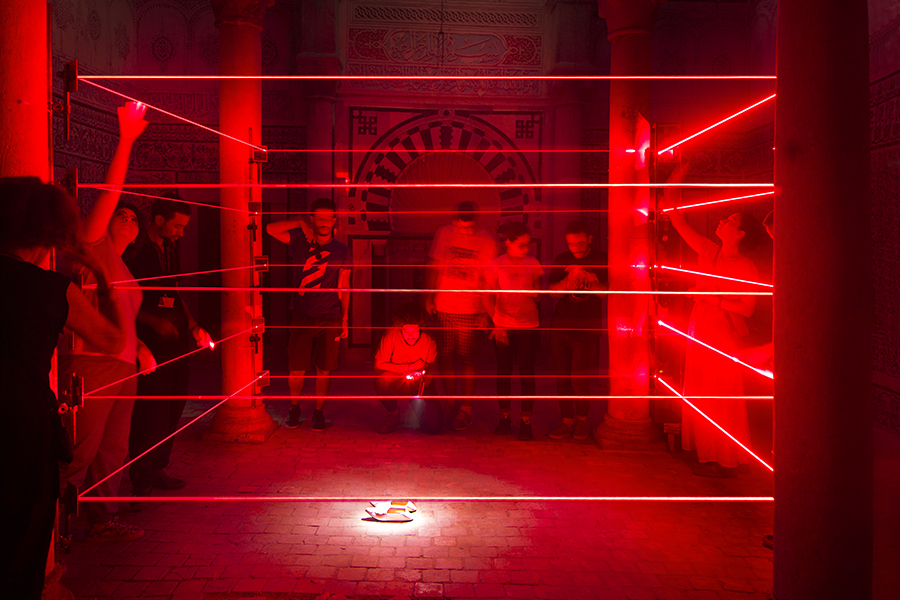 "Bordering Light" 2016, laser installation in the Madrasa Bir Lahjar, Tunis (Tunesia)
"Bordering Light" 2016, laser installation in the Madrasa Bir Lahjar, Tunis (Tunesia)
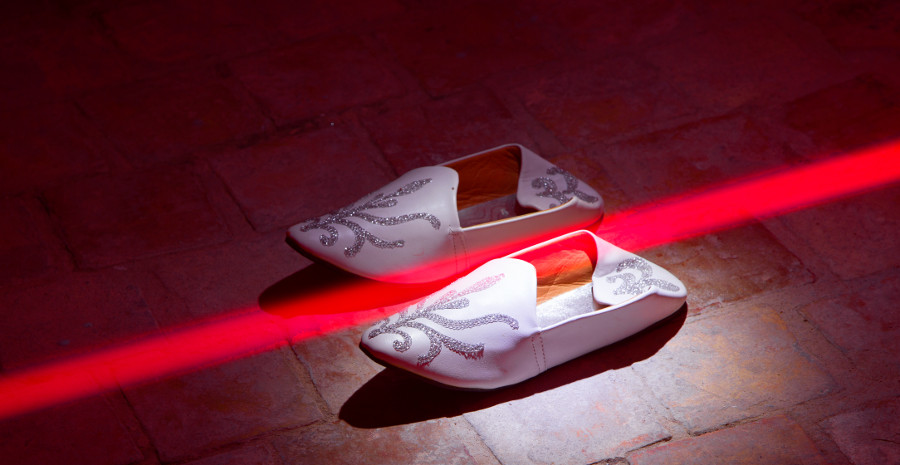 "Bordering Light" 2016, laser installation in the Madrasa Bir Lahjar, Tunis (Tunesia)
"Bordering Light" 2016, laser installation in the Madrasa Bir Lahjar, Tunis (Tunesia)
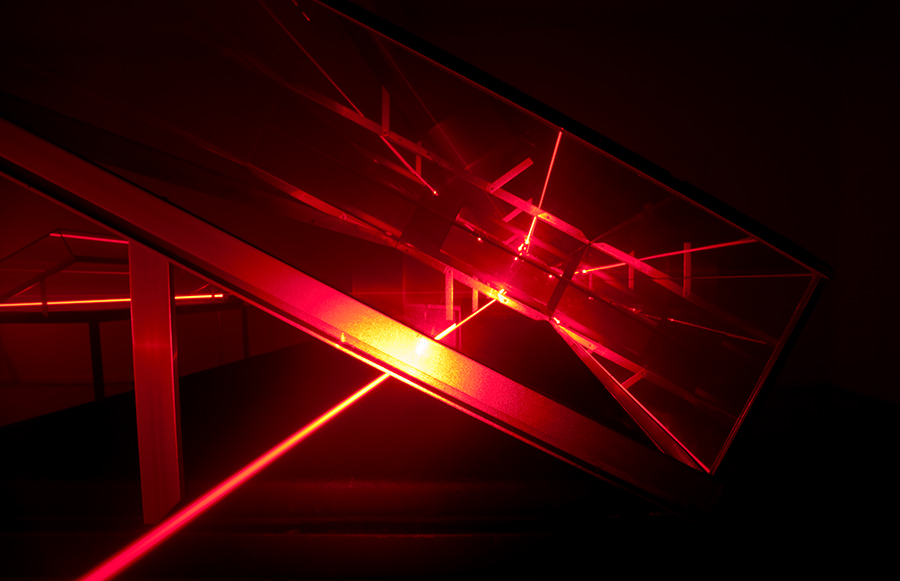 "Swathe of Light VI"2011, laser installation, Kunstverein
Linz a.Rh., Linz am Rhein (Germany),
"Swathe of Light VI"2011, laser installation, Kunstverein
Linz a.Rh., Linz am Rhein (Germany),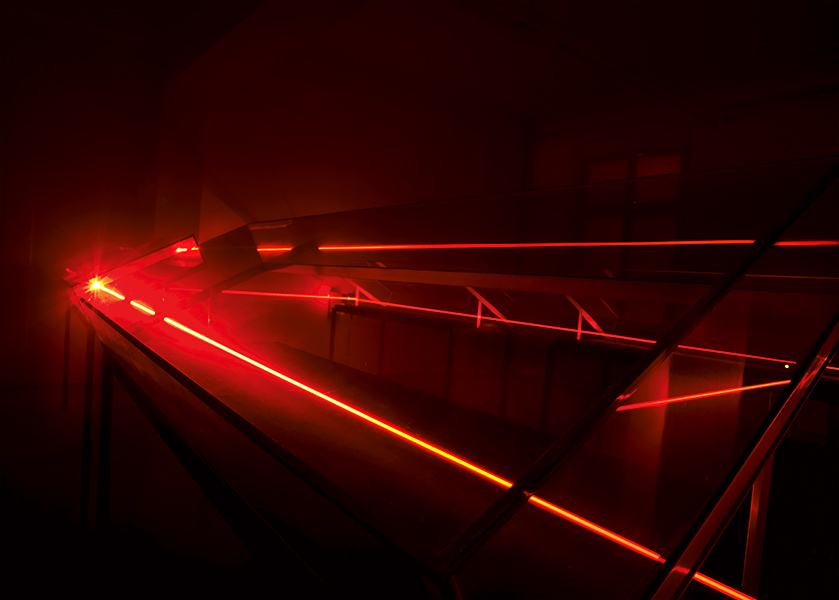
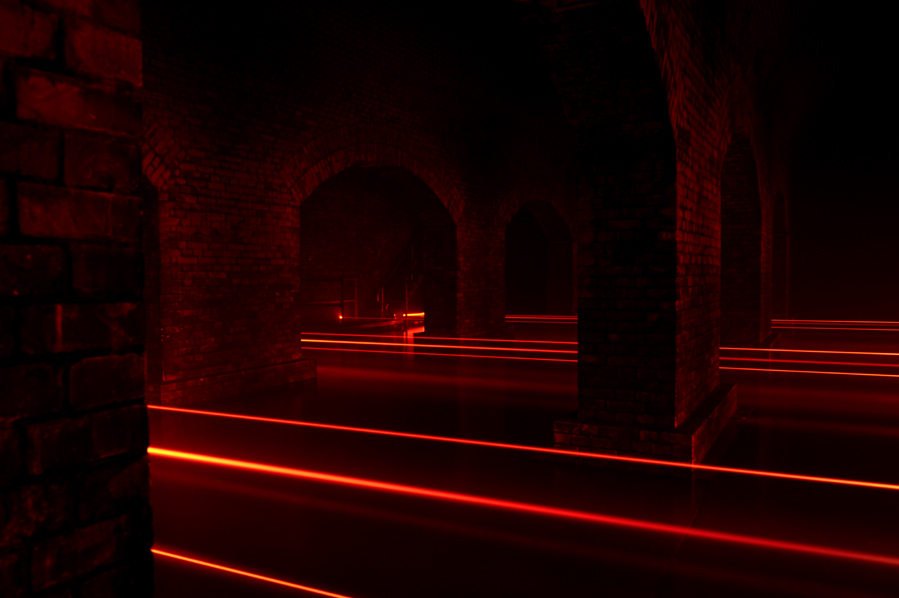 "Swathe of Light V"2010, laser installation in the Wasserreservoir Museum of Mathildenhöhe, Darmstadt (Germany)
"Swathe of Light V"2010, laser installation in the Wasserreservoir Museum of Mathildenhöhe, Darmstadt (Germany)
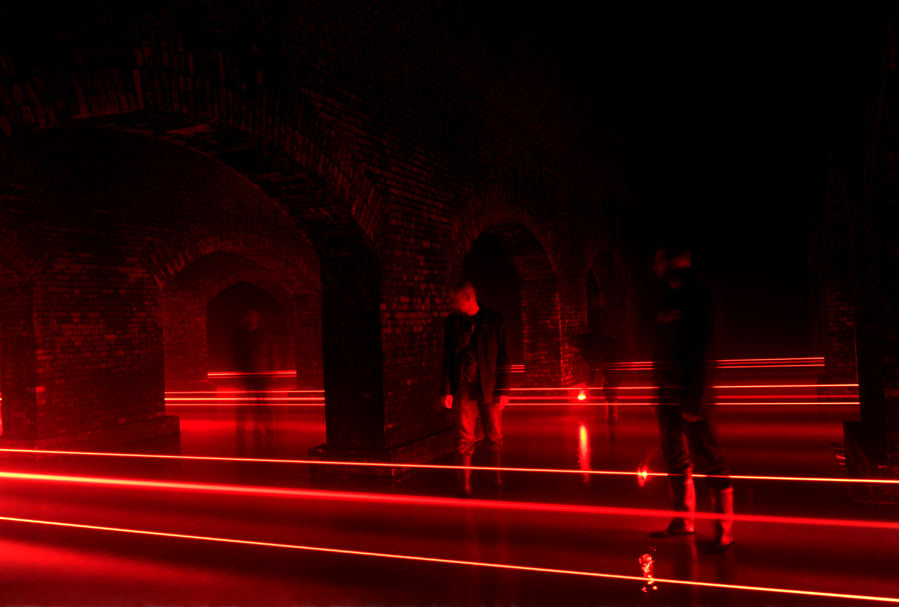 "Swathe of Light V"2010, laser installation in the Wasserreservoir of Museum Mathildenhöhe, Darmstadt (Germany)
"Swathe of Light V"2010, laser installation in the Wasserreservoir of Museum Mathildenhöhe, Darmstadt (Germany)
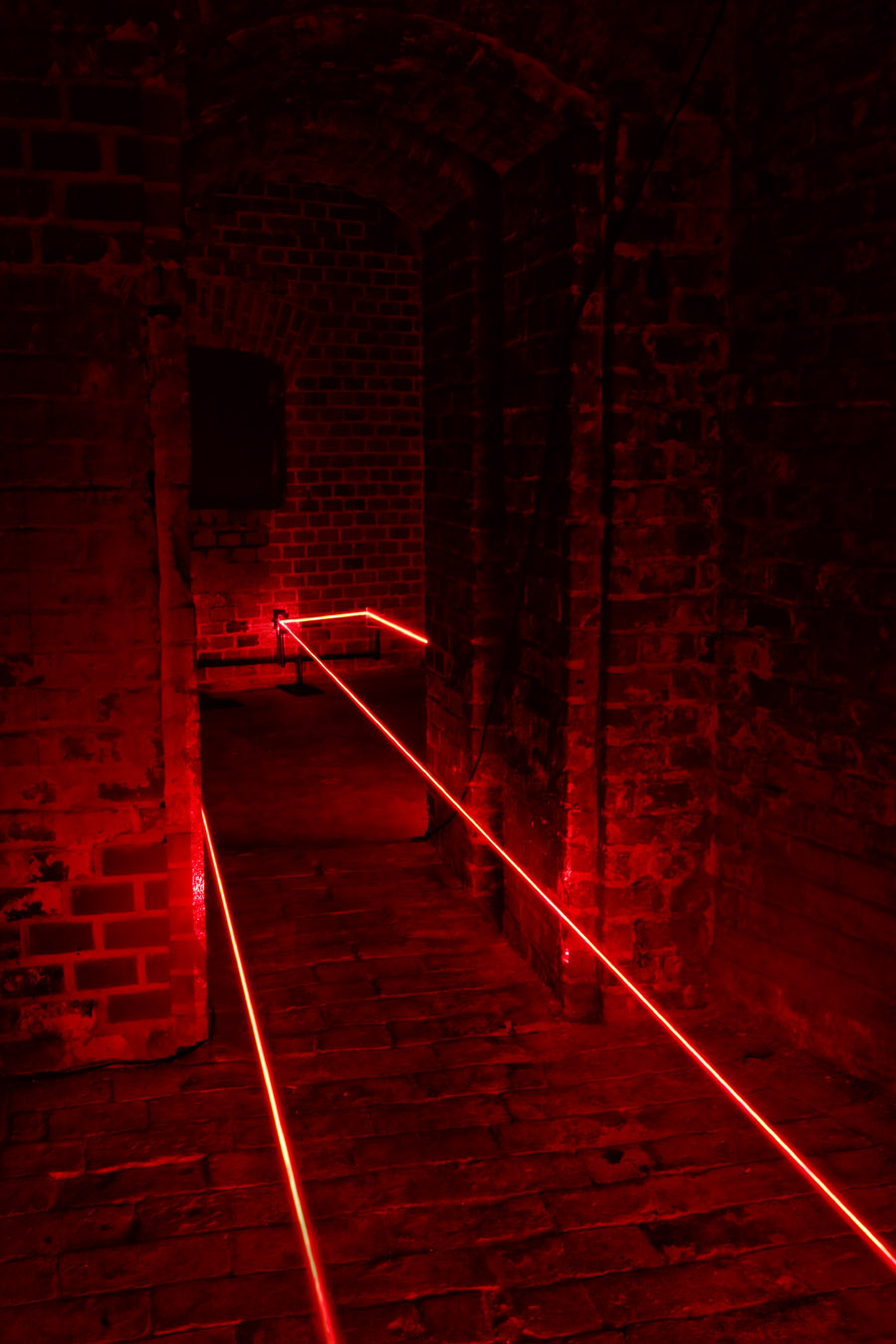 "swathe of light IV"2009, laser installation in the Zitadelle Spandau, Berlin (Germany)
"swathe of light IV"2009, laser installation in the Zitadelle Spandau, Berlin (Germany)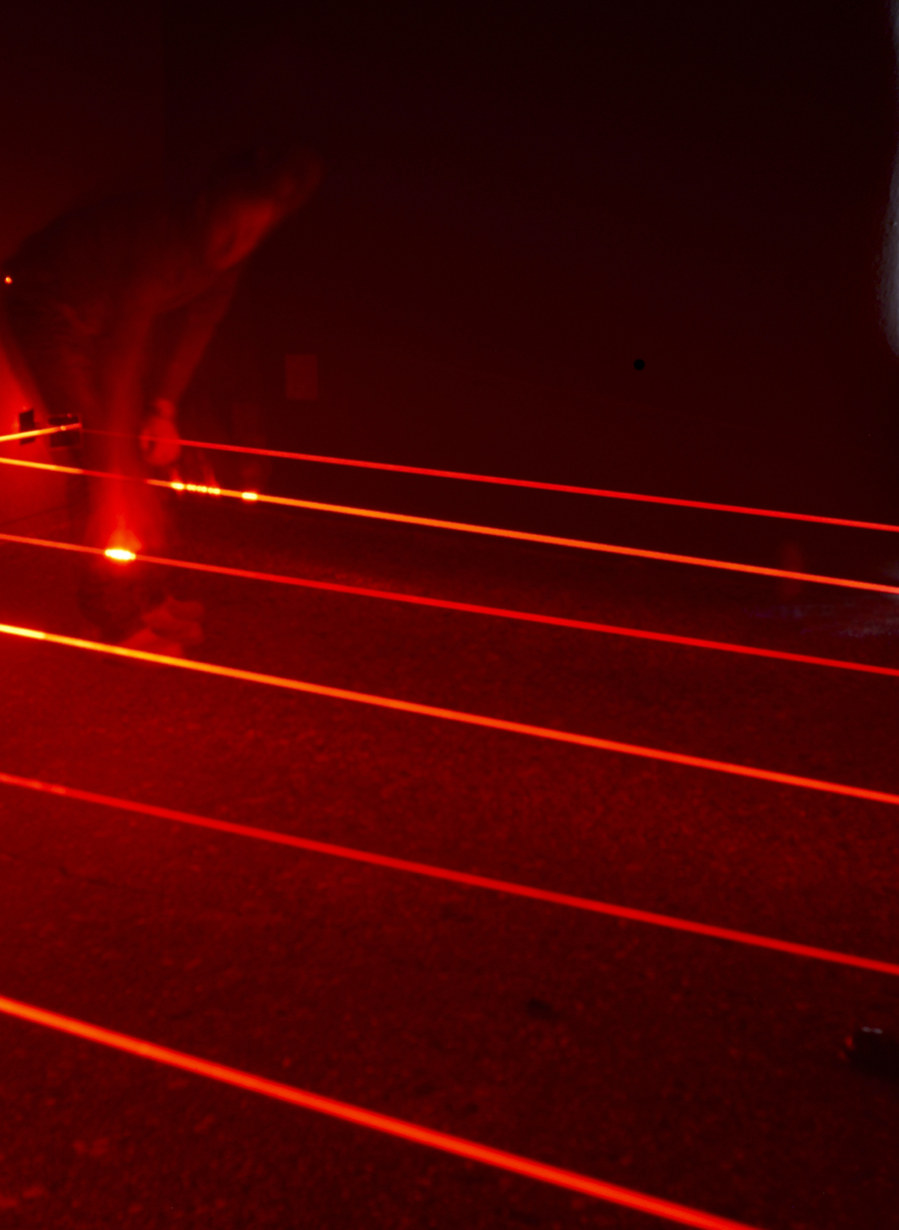
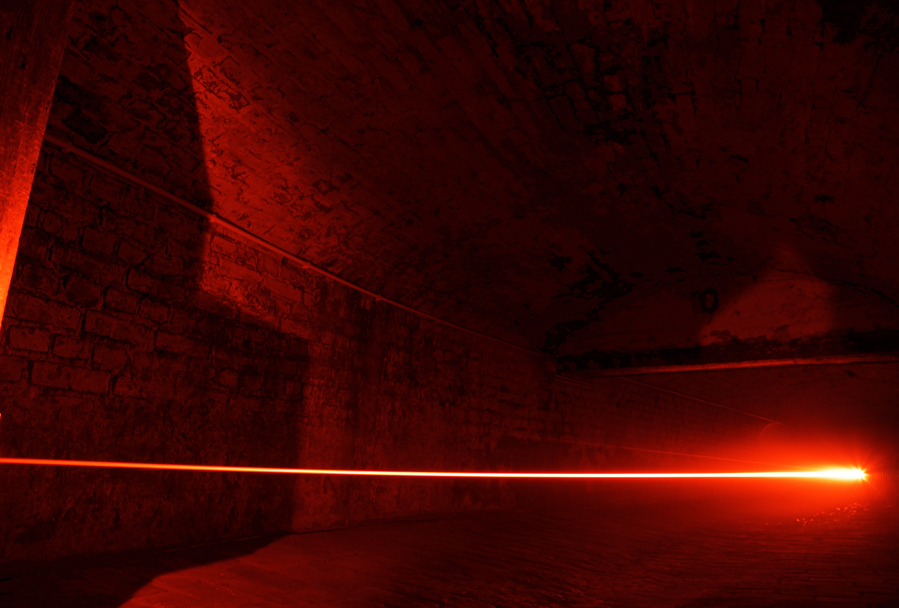 "swathe of light I" 2008 , laser installation in the 50 m horizontal tunnel of the Künstlerzeche "Unser Fritz" ,Herne (Germany)
"swathe of light I" 2008 , laser installation in the 50 m horizontal tunnel of the Künstlerzeche "Unser Fritz" ,Herne (Germany)